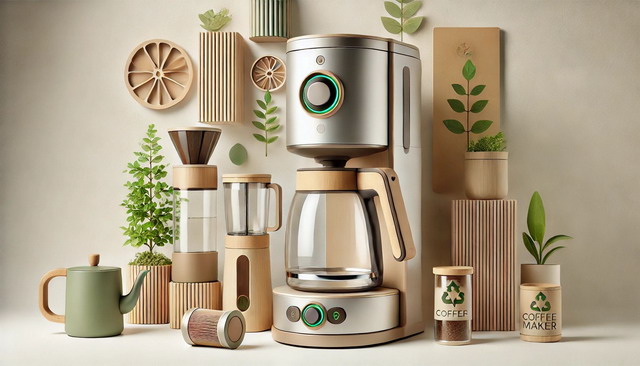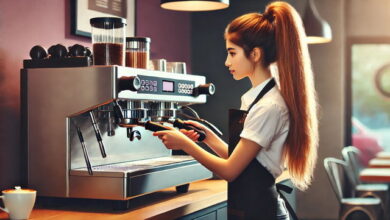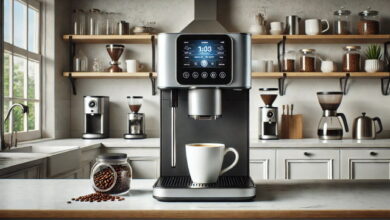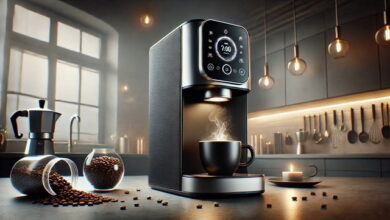Sustainable Coffee Maker Designs in 2025: A New Era of Eco-Friendly Brewing
Sustainable Coffee Maker Designs in 2025
As the world grapples with the growing impact of climate change and environmental degradation, sustainability is no longer a niche concern—it’s a global priority. Every industry, from fashion to technology, is being called upon to reduce its environmental footprint, and the coffee industry is no exception. Coffee is one of the most widely consumed beverages in the world, but it also leaves behind a significant environmental toll. From the cultivation of coffee beans to the energy-intensive brewing process and the waste generated from disposable filters and pods, the environmental impact of our daily coffee habit is substantial.
In response to this growing awareness, coffee maker manufacturers are shifting their focus to more eco-friendly designs that prioritize sustainability. By reducing energy consumption, minimizing waste, and using renewable or recycled materials, coffee makers in 2025 are transforming how we brew our favorite beverage. These innovations offer more than just convenience—they offer a way for consumers to enjoy coffee while reducing their impact on the planet.
This article will explore the latest advancements in sustainable coffee maker designs for 2025, including energy-efficient machines, the use of recycled materials, zero-waste brewing solutions, and the integration of smart technology. Whether you’re a coffee aficionado or someone looking to reduce their environmental footprint, these innovations offer exciting opportunities to make your coffee routine more sustainable. Let’s dive into the future of eco-friendly coffee brewing and discover how these new designs are shaping a greener, more responsible world.
Introduction to Sustainable Coffee Maker Designs
The concept of sustainability in coffee maker design revolves around reducing the environmental impact of the product from manufacturing to end-of-life. Traditional coffee makers often involve energy-hogging processes, plastic waste, and unsustainable materials. However, today’s eco-conscious consumers are demanding more. They want coffee machines that not only deliver a great cup of coffee but also do so without harming the environment. This shift is driving manufacturers to innovate, developing sustainable coffee makers that prioritize energy efficiency, reduce waste, and incorporate renewable or recycled materials.
In 2025, coffee lovers have more options than ever before. New designs are emerging that cater to the needs of the eco-conscious consumer, focusing on energy efficiency, material sustainability, and reducing overall waste. Whether it’s a smart coffee maker that optimizes power usage or a machine built with recycled materials, the focus on sustainability is reshaping the landscape of the coffee appliance market.
Best Energy-Efficient Coffee Makers in 2025
When we think about sustainability in coffee maker designs, energy efficiency is a critical factor. The amount of energy consumed during the brewing process has a direct impact on both the environment and your utility bills. Coffee makers traditionally use a lot of power, particularly models that keep water heated throughout the day or have a high standby energy consumption. However, the coffee machines of 2025 are designed to drastically reduce their energy usage, making them a win-win for both the planet and your wallet.
One of the most significant innovations in energy-efficient coffee makers is the integration of smart technology. These devices are equipped with sensors and programming that allow them to brew coffee at optimal times, automatically turning off when not in use or when the brewing cycle is complete. By incorporating smart energy management, coffee makers can save energy by avoiding unnecessary heating cycles or extended standby modes. For example, many models in 2025 are designed to only heat the exact amount of water needed for each brew, rather than maintaining a reservoir of hot water throughout the day.
Additionally, programmable timers and remote control features via smartphone apps allow users to schedule their coffee brewing precisely, further reducing energy waste. Consumers can set their coffee maker to start brewing right before they wake up, ensuring that the machine is only on for the necessary amount of time, which cuts down on energy consumption. Leading brands like Breville, Philips, and Keurig have embraced these smart features, offering machines that align with modern energy-conscious living.
Energy-efficient designs are not only limited to high-tech solutions. Manufacturers are also exploring more straightforward mechanisms to reduce energy usage. For instance, thermal carafe coffee makers are gaining popularity. Unlike traditional drip machines with hot plates that continuously consume electricity to keep coffee warm, thermal carafe models use insulated containers to maintain the temperature without external power. This simple yet effective design tweak prevents unnecessary energy waste while keeping coffee warm for hours.
Moreover, brands are now being more transparent about the energy consumption of their coffee makers. Many models in 2025 come with Energy Star ratings, helping consumers easily identify appliances that meet rigorous energy efficiency standards. By choosing an Energy Star-certified coffee maker, buyers can be assured that they are investing in a product that will minimize their energy use, making a meaningful impact on reducing their household’s overall carbon footprint.
Beyond reducing operational energy use, some coffee makers are also incorporating renewable energy sources, such as solar-powered designs. Although still a niche market, solar-powered coffee makers are an exciting innovation for sustainability enthusiasts. These machines can brew coffee using only the energy harvested from sunlight, completely eliminating the need for electricity from traditional power grids. Although solar coffee makers may not yet be mainstream, 2025 sees more interest and investment in developing these renewable-powered options.
Energy-efficient coffee makers don’t just benefit the environment—they also lead to substantial savings for the user. By reducing energy consumption, these machines help to lower electricity bills while still providing the convenience and quality consumers expect. In a time where climate change and energy shortages are a growing concern, making the switch to an energy-efficient coffee maker is a responsible and rewarding choice.
As we look to the future, the coffee makers of 2025 are setting a new standard for energy efficiency. Whether through smart technology, thermal carafes, or renewable energy sources, these designs reflect a broader trend toward sustainability in the appliance market. For eco-conscious consumers, energy-efficient coffee makers offer the perfect blend of functionality, cost-saving benefits, and a reduced environmental impact.
Coffee Makers Made from Recycled Materials: Reducing Waste from Start to Finish
One of the most significant shifts in coffee maker design in 2025 is the increased use of recycled materials in production. The coffee industry, like many other industries, is recognizing that it’s not just the end-of-life waste that needs addressing but also the environmental footprint of the materials used to manufacture coffee makers. This push for sustainable materials is driving manufacturers to rethink how they source and build their machines.
Coffee makers made from recycled materials are becoming increasingly popular as they provide an immediate way to reduce waste. From plastics and metals to packaging, brands are seeking out materials that would otherwise end up in landfills or pollute oceans. These products give discarded materials a second life, helping to lower the demand for new, raw materials and reducing the overall environmental impact of production.
In 2025, many companies are leading the charge by using post-consumer recycled plastic and stainless steel to construct their coffee machines. For instance, Philips and Nespresso have introduced lines of coffee makers that feature up to 50-60% recycled plastic in their components. This not only gives the machines an eco-friendly edge but also shows a commitment to reducing the use of virgin plastics, which contribute heavily to environmental degradation.
Moreover, some coffee maker brands have even partnered with environmental organizations to ensure that their products meet stringent sustainability standards. By adhering to certifications like Cradle to Cradle, which promotes the use of safe, sustainable, and circular materials, manufacturers are demonstrating that sustainability is more than just a marketing trend—it’s an integral part of their business models.
The use of recycled materials doesn’t just stop at the machines themselves. Companies are also rethinking how they package their products, using biodegradable, compostable, or fully recyclable packaging to minimize waste. In 2025, it’s common to see coffee makers sold in boxes made from recycled cardboard, without the need for plastic wrap or foam inserts. This comprehensive approach to sustainability, from product design to packaging, helps reduce the overall environmental impact and encourages a circular economy in the coffee industry.
Eco-Friendly Single Serve Coffee Makers: Solving the Pod Problem
Single-serve coffee makers, while convenient, have long been criticized for their environmental impact, particularly due to the non-recyclable plastic pods that have become synonymous with brands like Keurig and Nespresso. These pods, often made from a combination of plastic, aluminum, and paper, are difficult to recycle and contribute to massive amounts of landfill waste. However, in 2025, there’s a growing movement to make single-serve coffee more eco-friendly.
One of the most promising developments in this space is the introduction of biodegradable and compostable coffee pods. Unlike traditional pods, which can take hundreds of years to break down, these new alternatives are designed to decompose naturally, either in industrial compost facilities or even in your backyard. Brands like Nespresso and Lavazza are leading the way with compostable pods made from plant-based materials, which deliver the same convenience and taste but without the environmental burden.
Another innovation in the single-serve market is the rise of reusable coffee pods. These pods are typically made from stainless steel or durable plastic and can be filled with your choice of coffee grounds, then washed and reused indefinitely. Reusable pods eliminate the waste generated by single-use pods and allow consumers to control the type and quality of coffee they brew, often leading to a more personalized coffee experience.
Moreover, some companies are now designing machines that are specifically compatible with eco-friendly or reusable pods. For instance, Keurig has introduced a line of machines that not only accept compostable pods but also include built-in features for more sustainable brewing. These machines offer consumers the same convenience of single-serve brewing while dramatically reducing the waste associated with traditional pod systems.
In addition to addressing the pod problem, single-serve coffee makers in 2025 are also being designed with energy efficiency in mind. Many models now feature automatic shut-off functions, smart energy use, and rapid heating systems that reduce overall power consumption. This combination of waste reduction and energy efficiency makes eco-friendly single-serve coffee makers a more viable option for consumers who value convenience but are also concerned about their environmental footprint.
As more consumers seek out sustainable alternatives, the single-serve market is transforming. No longer synonymous with waste and inefficiency, single-serve coffee makers in 2025 are becoming greener, thanks to innovations in compostable pods, reusable systems, and energy-saving designs.
The Role of Smart Technology in Sustainable Coffee Makers
Smart technology is revolutionizing how we interact with everyday appliances, and coffee makers are no exception. In 2025, smart coffee makers are not only improving the user experience but also playing a key role in making coffee brewing more sustainable. By incorporating smart features, manufacturers can optimize energy usage, reduce waste, and help consumers make more eco-conscious choices.
One of the biggest contributions of smart technology to sustainability is in energy management. Smart coffee makers are designed to minimize energy waste by incorporating features like automatic shut-off, programmable timers, and power-saving modes. These machines can detect when they’re not in use and enter a low-power state or shut off entirely, ensuring that they don’t consume unnecessary electricity. This is particularly useful for people who forget to turn off their coffee machines or tend to leave them on throughout the day.
Beyond energy efficiency, smart technology is also helping to reduce coffee waste. Many smart coffee makers are equipped with precision brewing features, allowing users to select the exact amount of coffee they want to brew, down to the ounce. This reduces the risk of over-brewing and wasting coffee, which is not only cost-effective but also eco-friendly. Some machines can even monitor the freshness of the coffee grounds and notify the user when it’s time to replace them, ensuring that the coffee is brewed at its peak quality without waste.
Additionally, smart coffee makers are often connected to smartphone apps, giving users more control over their brewing habits. Through these apps, consumers can track their energy usage, set brewing schedules, and receive recommendations on how to reduce their environmental impact. Some apps even offer tips on sustainable coffee sourcing, helping consumers make better choices not just in terms of appliances but also the coffee beans they purchase.
The integration of smart technology into coffee makers is not only making the brewing process more convenient but also significantly enhancing sustainability. By reducing energy consumption and minimizing waste, smart coffee makers in 2025 are helping to create a more sustainable coffee culture, one cup at a time.
Solar-Powered Coffee Makers: A New Trend?
In 2025, solar energy is finding its way into unexpected places—including coffee brewing. As renewable energy continues to grow in popularity, the coffee industry is experimenting with ways to incorporate solar power into daily coffee routines. Solar-powered coffee makers, once a niche idea, are slowly gaining traction as an innovative solution for eco-conscious consumers. While still emerging, these machines are beginning to carve out a space in the market, offering a new way to enjoy coffee while minimizing environmental impact.
Solar-powered coffee makers harness energy from the sun, eliminating the need for electricity from conventional grids. These devices are equipped with solar panels, which store energy during daylight hours. Some models can be entirely off-grid, making them an attractive option for those living in areas with limited access to electricity or for individuals aiming to reduce their carbon footprint as much as possible. Portable solar-powered coffee makers are also being introduced for camping, hiking, or other outdoor activities, where traditional power sources may be unavailable.
However, while the technology is promising, solar-powered coffee makers still face challenges. The biggest hurdle is efficiency—ensuring that solar panels can capture enough energy to heat water and brew coffee in a timely manner. Currently, most solar-powered models are designed for low-energy brewing methods, such as pour-over or French press, which require less energy compared to traditional drip or espresso machines. This means that for now, solar-powered coffee makers might be slower or more limited in their capabilities compared to their electric counterparts.
Despite these limitations, the potential for solar-powered coffee makers is vast. With improvements in solar panel efficiency and battery storage technology, we can expect to see more powerful and versatile solar coffee machines in the future. Some companies are already working on hybrid models that combine solar power with battery backup systems, ensuring that users can brew coffee even on cloudy days or during nighttime.
In 2025, solar-powered coffee makers may not yet be mainstream, but they represent a bold step toward reducing reliance on fossil fuels and embracing renewable energy in everyday appliances. For environmentally conscious consumers, solar-powered coffee makers offer a glimpse into a future where coffee brewing can be both off-grid and sustainable, with zero impact on the environment.
Coffee Makers with Reusable Filters: An Eco-Friendly Solution
One of the most straightforward but impactful innovations in sustainable coffee maker design is the shift from disposable paper filters to reusable ones. Coffee makers with reusable filters have been around for some time, but in 2025, their popularity is soaring as consumers seek to cut down on single-use waste. These eco-friendly filters are usually made from stainless steel or durable mesh materials, allowing them to be washed and reused countless times, rather than being thrown away after each use.
The environmental benefits of reusable filters are clear. Paper filters, while compostable, still contribute to deforestation and create waste when disposed of improperly. With billions of coffee drinkers worldwide, the cumulative impact of using disposable filters is significant. By switching to reusable filters, coffee drinkers can drastically reduce the amount of waste they produce, making their coffee routine much more sustainable.
Another advantage of reusable filters is that they often allow more of the coffee’s natural oils to pass through, enhancing the flavor of the brew. Many coffee enthusiasts argue that reusable filters produce a richer, more robust cup of coffee compared to paper filters, which can absorb some of the oils and alter the taste. This means that beyond their environmental benefits, reusable filters can also improve the overall coffee experience.
Manufacturers are now designing coffee makers that come equipped with built-in reusable filters as a standard feature. Leading brands like Cuisinart, Hamilton Beach, and Breville have introduced models that include high-quality, easy-to-clean reusable filters, making the transition away from disposable paper filters seamless for consumers. Additionally, many of these filters are designed to be compatible with various coffee grounds, including fine espresso grounds or coarser options for French press-style brewing.
For those who already own coffee makers that use disposable filters, there are now many third-party reusable filter options available. These filters are typically universal, fitting into standard drip coffee makers and offering an easy way for consumers to retrofit their machines for sustainability.
In 2025, the movement toward reusable filters is more than just a trend—it’s a practical, affordable, and eco-friendly solution that benefits both the environment and the quality of the coffee. As more people become aware of the environmental impact of their coffee habits, reusable filters are likely to become the norm rather than the exception.
Low-Water Usage Coffee Machines for Water Conservation
Water is one of the most precious resources on the planet, and coffee brewing, while not as water-intensive as other industries, still has a significant impact on water consumption. Recognizing the importance of conserving water, many coffee maker manufacturers are focusing on developing low-water usage coffee machines in 2025. These machines are designed to optimize water usage, ensuring that every drop is used efficiently and reducing overall waste.
One of the key features of low-water usage coffee makers is precision brewing, where the machine only heats and dispenses the exact amount of water needed for each cup of coffee. This eliminates the common problem of brewing more coffee than necessary, which often leads to wasted water and coffee. By allowing users to precisely control the amount of water per brew, these machines not only conserve water but also provide a more customized coffee experience.
Another innovation in water conservation comes in the form of steam or pressure-based brewing methods. Machines like espresso makers, which use high pressure to extract flavor from the coffee grounds, require less water overall than traditional drip coffee makers. As a result, espresso machines tend to be more water-efficient while still delivering a strong, flavorful cup of coffee.
Some coffee makers in 2025 are also equipped with built-in water filters, which ensure that the water used in brewing is pure and clean, reducing the need for frequent water replacements. By improving water quality, these machines help extend the life of the coffee maker and reduce the overall water footprint. This is especially important in areas where water quality is a concern, as filtered water leads to better-tasting coffee and less waste.
In addition to the design of the machines themselves, manufacturers are also promoting water-saving practices to consumers. Many coffee makers now come with guidelines on how to brew using the least amount of water possible, and some even include features that measure water usage over time, helping users track and reduce their consumption. This combination of efficient machine design and user education is helping coffee drinkers become more mindful of their water use.
Low-water usage coffee machines are especially important in regions facing water scarcity or drought conditions. By adopting water-saving technologies, these machines contribute to broader efforts to conserve water resources and promote sustainable living practices. In 2025, coffee makers that prioritize water conservation are not just a responsible choice—they are a necessity in a world increasingly affected by climate change and water shortages.
Zero-Waste Coffee Maker Designs: A Future Standard?
As sustainability becomes a central focus for consumers in 2025, the coffee industry is responding with innovations aimed at eliminating waste. One of the most exciting developments is the rise of zero-waste coffee makers, designed to minimize or completely eliminate waste associated with brewing coffee. From the materials used in manufacturing to the disposal of spent coffee grounds and filters, zero-waste coffee makers represent the next frontier in sustainable coffee consumption.
The concept of zero waste revolves around the idea that every part of the coffee-making process can either be reused, recycled, or composted. This means no plastic waste from disposable pods, no paper waste from single-use filters, and no coffee grounds ending up in landfills. Manufacturers are incorporating eco-friendly materials like compostable or recyclable plastics, glass, and metals, ensuring that when the coffee maker reaches the end of its life, its components can be disassembled and recycled.
A key element of zero-waste coffee makers is the reduction of single-use components, particularly in the single-serve market. As discussed earlier, disposable pods are a major contributor to coffee-related waste, but in 2025, brands are making strides with refillable, reusable, and compostable pod alternatives. In zero-waste coffee makers, consumers are encouraged to use reusable pods and grounds, drastically cutting down on daily waste production.
Another aspect of zero-waste design is the way coffee grounds are handled. Traditionally, used coffee grounds are often discarded in the trash, but zero-waste machines aim to repurpose them. Coffee grounds are rich in nutrients and can be composted, providing a sustainable solution that transforms waste into a valuable resource. Some innovative zero-waste coffee makers even include built-in composting systems, allowing users to easily collect and store coffee grounds for garden use.
Leading brands are also experimenting with designs that reduce packaging waste. In 2025, it’s becoming common to see coffee makers shipped in fully recyclable or biodegradable packaging. Companies are doing away with plastic foam inserts, excessive wrapping, and non-recyclable components, ensuring that from the moment the product is unboxed, its environmental impact is minimal.
Zero-waste coffee makers aren’t just about minimizing physical waste—they also focus on reducing energy and water consumption. Many of these machines come equipped with energy-saving features and precise water control to ensure that users only consume what they need. This all-encompassing approach to sustainability makes zero-waste coffee makers a strong contender for the future standard of coffee appliances.
Although zero-waste designs are still in their early stages in 2025, they are quickly gaining popularity among eco-conscious consumers. As more people recognize the environmental impact of their coffee habits, the demand for truly sustainable, zero-waste coffee makers is expected to grow. The combination of waste reduction, composting, and efficient resource use positions zero-waste coffee makers as a crucial part of the sustainable coffee revolution.
Consumer Guide to Choosing a Sustainable Coffee Maker in 2025
As the market for sustainable coffee makers expands, consumers are faced with a variety of choices that reflect different aspects of eco-friendly design. Whether you’re motivated by energy efficiency, waste reduction, or material sustainability, finding the right coffee maker can feel overwhelming. Here’s a guide to help you navigate the options and choose a coffee maker that aligns with your sustainability goals in 2025.
- Consider Energy Efficiency
One of the most important factors in selecting a sustainable coffee maker is energy efficiency. Look for models with energy-saving features, such as automatic shut-off, smart timers, and low-power modes. Machines with Energy Star certifications are a reliable choice for minimizing energy use. If you want to take it a step further, consider investing in a solar-powered coffee maker, which completely eliminates the need for electricity from traditional grids.
- Prioritize Reusable and Recyclable Components
Avoid coffee makers that rely on disposable single-use items like paper filters or plastic pods. Instead, opt for machines with reusable filters or refillable pods, which significantly reduce waste. Check that the machine itself is made from sustainable materials—look for models that use recycled plastic, stainless steel, or glass, and ensure that the components are recyclable when the coffee maker reaches the end of its life.
- Look for Water-Saving Features
If water conservation is a priority, choose a coffee maker that uses precision brewing technology. These machines allow you to brew exactly the amount of coffee you need, avoiding unnecessary water waste. Additionally, consider coffee makers that incorporate water filters, ensuring that you get the most out of every drop.
- Choose Compostable or Zero-Waste Solutions
For consumers looking to minimize their environmental footprint, zero-waste coffee makers offer the ultimate in sustainability. These machines often feature built-in composting options for coffee grounds and are designed to reduce or eliminate single-use components. Look for coffee makers that prioritize compostable materials and offer reusable solutions to cut down on daily waste.
- Check for Certifications
Certifications can be a helpful way to ensure that the coffee maker you’re purchasing meets high standards of sustainability. Look for labels like Energy Star, Cradle to Cradle, or the Forest Stewardship Council (FSC), which indicate that the product has been manufactured with environmental considerations in mind.
By focusing on these key factors, you can find a sustainable coffee maker that meets both your brewing needs and your environmental values. In 2025, there are more options than ever for consumers who want to enjoy their coffee with a minimal impact on the planet.
Conclusion: The Future of Sustainable Coffee Makers
The coffee makers of 2025 represent a new era of innovation where sustainability is at the forefront of design. From energy-efficient models to machines made with recycled materials, the industry is transforming to meet the demands of eco-conscious consumers. Solar-powered coffee makers, reusable filters, and low-water usage designs offer practical solutions to reduce the environmental impact of brewing coffee. Meanwhile, the growing trend of zero-waste coffee makers shows that the future of coffee brewing is not only about reducing waste but eliminating it entirely.
As the coffee industry continues to evolve, consumers have a powerful role to play in driving this change. By choosing sustainable coffee makers, individuals can significantly reduce their carbon footprint and support companies that prioritize the planet. In a world increasingly affected by climate change, these small choices add up, contributing to a more sustainable future for both coffee lovers and the environment.
In conclusion, the innovations in sustainable coffee maker designs are transforming how we approach our daily coffee rituals. Whether through energy efficiency, waste reduction, or renewable energy use, 2025 is a pivotal year for the coffee industry’s sustainability efforts. With more eco-friendly options than ever, the choice is clear: the future of coffee brewing is green, and it’s time for everyone to join the movement toward a more sustainable cup of coffee.








